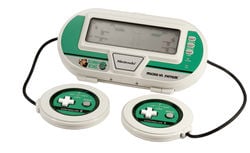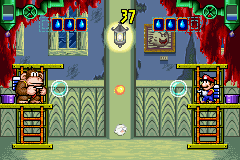Donkey Kong 3 (Game & Watch): Difference between revisions
No edit summary |
No edit summary Tags: Mobile edit Advanced mobile edit |
||
| (124 intermediate revisions by 38 users not shown) | |||
| Line 1: | Line 1: | ||
[[ | {{italic title}} | ||
'''''Donkey Kong 3''''' | {{game infobox | ||
|image=[[File:Game watch donkey kong 3-1-.jpg|250px]] | |||
|developer=[[Nintendo Research & Development 1]] | |||
|publisher=[[Nintendo]] | |||
|release=August 20, 1984<ref name=release>[http://web.archive.org/web/20220304100550/http://www.intheattic.co.uk/donkey_kong_3.htm ''Donkey Kong 3'' info page on In The Attic, a website dedicated to classic videogames] (Internet Archive: Wayback Machine). Retrieved 13 November 2010</ref> | |||
|genre=[[Genre#Platform games|Platformer]] | |||
|ratings=N/A | |||
|modes=Single player, multiplayer (up to two players simultaneously) | |||
|platforms=[[Game & Watch]] | |||
|format={{format|gaw=1}} | |||
|input={{input|gaw=1}} | |||
}} | |||
'''''Donkey Kong 3''''' is a [[Game & Watch]] version of the [[Donkey Kong 3|original arcade game of the same name]]. It was released as part of the Micro VS. System series on August 20, 1984.<ref name=release/> It was later included as a [[minigame]] in ''[[Game & Watch Gallery 4]]'' with a Classic mode and an updated "Modern" mode. | |||
[[File:AK-302 Bell1.gif|thumb|left|The alarm bell]] | |||
The alarm indicator for this game is a bell that is located beside Player 1's miss counter and spray value counter, and the bell flashes when the alarm goes off. | |||
{{br|left}} | |||
==Story== | |||
Just like in the arcade version, [[Donkey Kong]] breaks into [[Stanley]]'s greenhouse, but both are now armed with [[sprayer]]s. Using their sprayers, they attempt to force [[Buzzbee|bee]]s to sting each other. | |||
==Gameplay== | |||
===Classic version=== | |||
[[File:G&WG4 Donkey Kong 3.png|thumb|left|260px|The Classic version of ''Donkey Kong 3'']] | |||
In Game A, the player controls Stanley, who has to battle the computer-controlled Donkey Kong. Stanley and Donkey Kong are at opposite sides of the screen, each holding a spray of insecticide. Each must use his can to push bees towards his opponent. After a bee successfully reaches one side of the screen, the character on that side gets stung. The player earns a [[point]] every time their cloud of insecticide sends a bee toward Donkey Kong's side. The player earns 10 points if a bee reaches Donkey Kong's side. However, the objective is not as simple as firing insecticide towards the player's opponent. The bees move up and down the screen, forcing the player to do the same if to succeed. Also, each of the two characters has a limited supply of insecticide, which can be refilled; however, the player's back is turned while the player is refilling, rendering them defenseless. The player gets a miss if a bee reaches their side. When the player gets three misses, they receive a [[Game Over]]. | |||
Misses cannot be removed in this game, so players have to be cautious while playing. | |||
Game B features a two-player mode, and the speed at which Stanley's insecticide drips can be adjusted. Both characters start with 50 points. When a bee reaches a player's side, that player loses points. A player gets a miss if their score reaches zero. | |||
===Modern version=== | |||
[[File:GWG4-Donkey Kong 3 Gameplay.PNG|frame|left|The Modern version of ''Donkey Kong 3'']] | |||
The Modern version has a few differences. First, [[Mario]] replaces Stanley (just like how an [[Yoshi (species)|Orange Yoshi]] replaces him for the Modern mode of ''[[Greenhouse]]'' in ''[[Game & Watch Gallery 3]]''). Mario and Donkey Kong also have bubble shooters instead of insecticide sprays. Plus, the setting is a [[Ghost House]]. Lastly, the bees have been replaced by a [[fireball (obstacle)|fireball]] and a [[Boo]]. The fireball remains in place until pushed away by the bubbles. The Boo attempts to sneak up on either Mario or Donkey Kong when one of them is busy refilling his bubble shooter. When the fireball or Boo reaches Mario's or Donkey Kong's side, whoever receives it freaks out. Unlike in the Classic version, music is featured. | |||
If the player selects this game without actually starting it, it shows a humorous sequence. In it, Mario and Donkey Kong, in a similar manner to Wild West gun duels, take three steps forward before promptly turning to face each other and firing their bubble shooters rapidly and continuously, only for the bubbles to coalesce into one giant bubble and detonate to such an extent that both Mario and Donkey Kong are knocked away. | |||
{{br|left}} | |||
==Controls== | |||
*{{button|gba|pad}}: Move | |||
*{{button|gba|A}} and {{button|gba|B}}: Spray | |||
==Gallery== | |||
<gallery> | |||
DK3GW.jpg|Box art for ''Donkey Kong 3'' | |||
</gallery> | |||
===Modern version=== | |||
<gallery> | |||
DK-GWGallery4DK3.png|[[Donkey Kong]] | |||
GWG4DonkeyKong3MarioSprite.png|[[Mario]] | |||
G&WG4 Modern Donkey Kong 3 Boo.png|[[Boo]] | |||
G&WG4 Modern Donkey Kong 3 Bubble.png|[[Bubble]] | |||
G&WG4 Modern Donkey Kong 3 Fireball.png|[[Fireball (obstacle)|Fireball]] | |||
</gallery> | |||
==References== | |||
{{NIWA|NWiki=1}} | |||
<references/> | |||
{{Donkey Kong games}} | |||
{{Game & Watch}} | {{Game & Watch}} | ||
{{Game & Watch Gallery}} | |||
[[Category: Game & Watch Games]] | [[Category:Game & Watch games]] | ||
[[Category:1984 games]] | |||
[[Category:Games]] | |||
[[Category:Donkey Kong series]] | |||
[[Category:Platforming games]] | |||
[[Category:Game & Watch Gallery 4 minigames]] | |||
[[de:Donkey Kong 3 (Game & Watch)]] | |||
Latest revision as of 01:06, September 27, 2024
| Donkey Kong 3 | |
|---|---|

| |
| Developer | Nintendo Research & Development 1 |
| Publisher | Nintendo |
| Platform(s) | Game & Watch |
| Release date | August 20, 1984[1] |
| Genre | Platformer |
| Rating(s) | N/A |
| Mode(s) | Single player, multiplayer (up to two players simultaneously) |
| Format | Game & Watch:
Built-in
|
| Input | Game & Watch:
|
Donkey Kong 3 is a Game & Watch version of the original arcade game of the same name. It was released as part of the Micro VS. System series on August 20, 1984.[1] It was later included as a minigame in Game & Watch Gallery 4 with a Classic mode and an updated "Modern" mode.
The alarm indicator for this game is a bell that is located beside Player 1's miss counter and spray value counter, and the bell flashes when the alarm goes off.
Story[edit]
Just like in the arcade version, Donkey Kong breaks into Stanley's greenhouse, but both are now armed with sprayers. Using their sprayers, they attempt to force bees to sting each other.
Gameplay[edit]
Classic version[edit]
In Game A, the player controls Stanley, who has to battle the computer-controlled Donkey Kong. Stanley and Donkey Kong are at opposite sides of the screen, each holding a spray of insecticide. Each must use his can to push bees towards his opponent. After a bee successfully reaches one side of the screen, the character on that side gets stung. The player earns a point every time their cloud of insecticide sends a bee toward Donkey Kong's side. The player earns 10 points if a bee reaches Donkey Kong's side. However, the objective is not as simple as firing insecticide towards the player's opponent. The bees move up and down the screen, forcing the player to do the same if to succeed. Also, each of the two characters has a limited supply of insecticide, which can be refilled; however, the player's back is turned while the player is refilling, rendering them defenseless. The player gets a miss if a bee reaches their side. When the player gets three misses, they receive a Game Over.
Misses cannot be removed in this game, so players have to be cautious while playing.
Game B features a two-player mode, and the speed at which Stanley's insecticide drips can be adjusted. Both characters start with 50 points. When a bee reaches a player's side, that player loses points. A player gets a miss if their score reaches zero.
Modern version[edit]
The Modern version has a few differences. First, Mario replaces Stanley (just like how an Orange Yoshi replaces him for the Modern mode of Greenhouse in Game & Watch Gallery 3). Mario and Donkey Kong also have bubble shooters instead of insecticide sprays. Plus, the setting is a Ghost House. Lastly, the bees have been replaced by a fireball and a Boo. The fireball remains in place until pushed away by the bubbles. The Boo attempts to sneak up on either Mario or Donkey Kong when one of them is busy refilling his bubble shooter. When the fireball or Boo reaches Mario's or Donkey Kong's side, whoever receives it freaks out. Unlike in the Classic version, music is featured.
If the player selects this game without actually starting it, it shows a humorous sequence. In it, Mario and Donkey Kong, in a similar manner to Wild West gun duels, take three steps forward before promptly turning to face each other and firing their bubble shooters rapidly and continuously, only for the bubbles to coalesce into one giant bubble and detonate to such an extent that both Mario and Donkey Kong are knocked away.
Controls[edit]
 : Move
: Move and
and  : Spray
: Spray
Gallery[edit]
Modern version[edit]
References[edit]
- ^ a b Donkey Kong 3 info page on In The Attic, a website dedicated to classic videogames (Internet Archive: Wayback Machine). Retrieved 13 November 2010
| Game & Watch games | ||
|---|---|---|
| Super Mario franchise | Donkey Kong (1982, MS) • Mario Bros. (1983, MS) • Mario's Cement Factory (1983, TT/NWS) • Mario's Bombs Away (1983, PS) • Donkey Kong Hockey (1984, MVS) • Super Mario Bros. (1986, CrS | 1987, Sp | 1988, NWS) • Mario the Juggler (1991, NWS) • Game & Watch: Super Mario Bros. (2020, CoS) | |
| Donkey Kong franchise | Donkey Kong (1982, MS) • Donkey Kong Jr. (1982, NWS | 1983, TT & PS) • Donkey Kong II (1983, MS) • Donkey Kong 3 (1984, MVS) • Donkey Kong Circus (1984, PS) • Donkey Kong Hockey (1984, MVS) | |
| Miscellaneous | Green House (1982, MS) | |
| MS: Multi Screen • TT: Table Top • PS: Panorama Screen • NWS: New Wide Screen • MVS: Micro VS. System • CrS: Crystal Screen • Sp: Special • CoS: Color Screen | ||
| Game & Watch Gallery series | ||
|---|---|---|
| Games | Game & Watch Gallery (1997, GB) • Game & Watch Gallery 2 (1997, GB) • Game & Watch Gallery 3 (1999, GBC) • Game & Watch Gallery 4 (2002, GBA) | |
| Super Mario minigames | Donkey Kong2,4 • Donkey Kong Jr.3,4 • Donkey Kong II3 • Donkey Kong 34 • Mario Bros.3,4 • Mario's Bombs Away4 • Mario's Cement Factory4 | |
| Minigames remade with Super Mario content |
Ball2 • Boxing4 • Chef2,4 • Egg3 • Fire1,4 • Fire Attack4 • Greenhouse3 • Helmet2 • Manhole1 • Octopus1,4 • Oil Panic1 • Parachute2 • Rain Shower4 • Turtle Bridge3 • Vermin2 | |
| Gallery Corner | Message Board • Museum • Music Room | |
| Further info | Gallery (2 · 4) • Pre-release and unused content (4) • Staff (2 · 3 · 4) | |
| Related game | Game & Watch Collection | |







